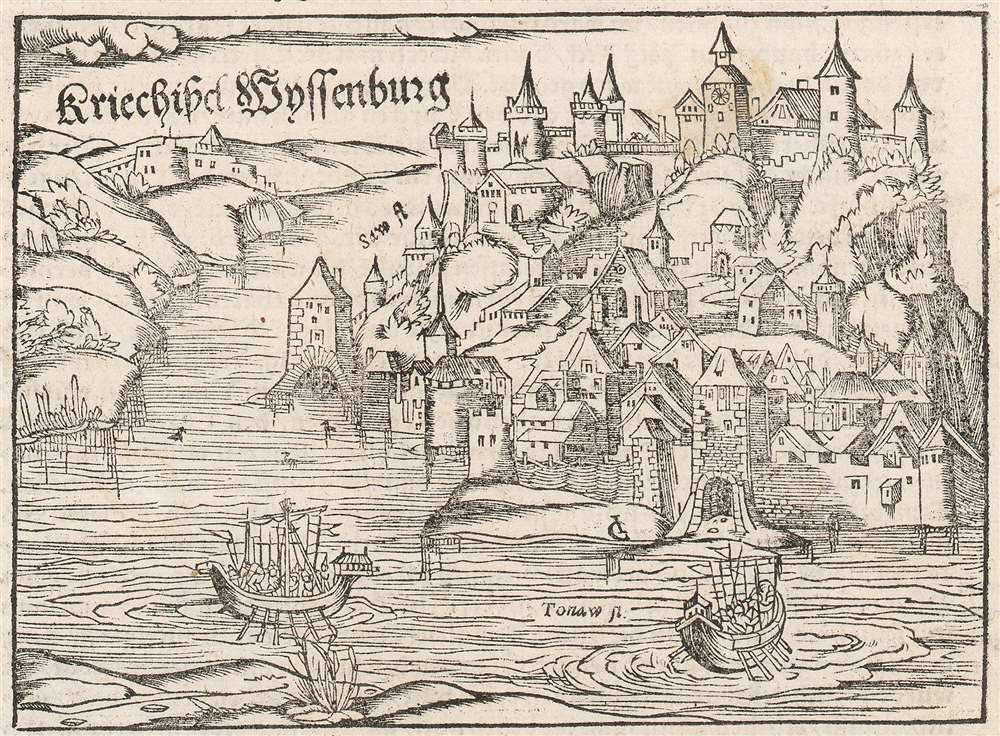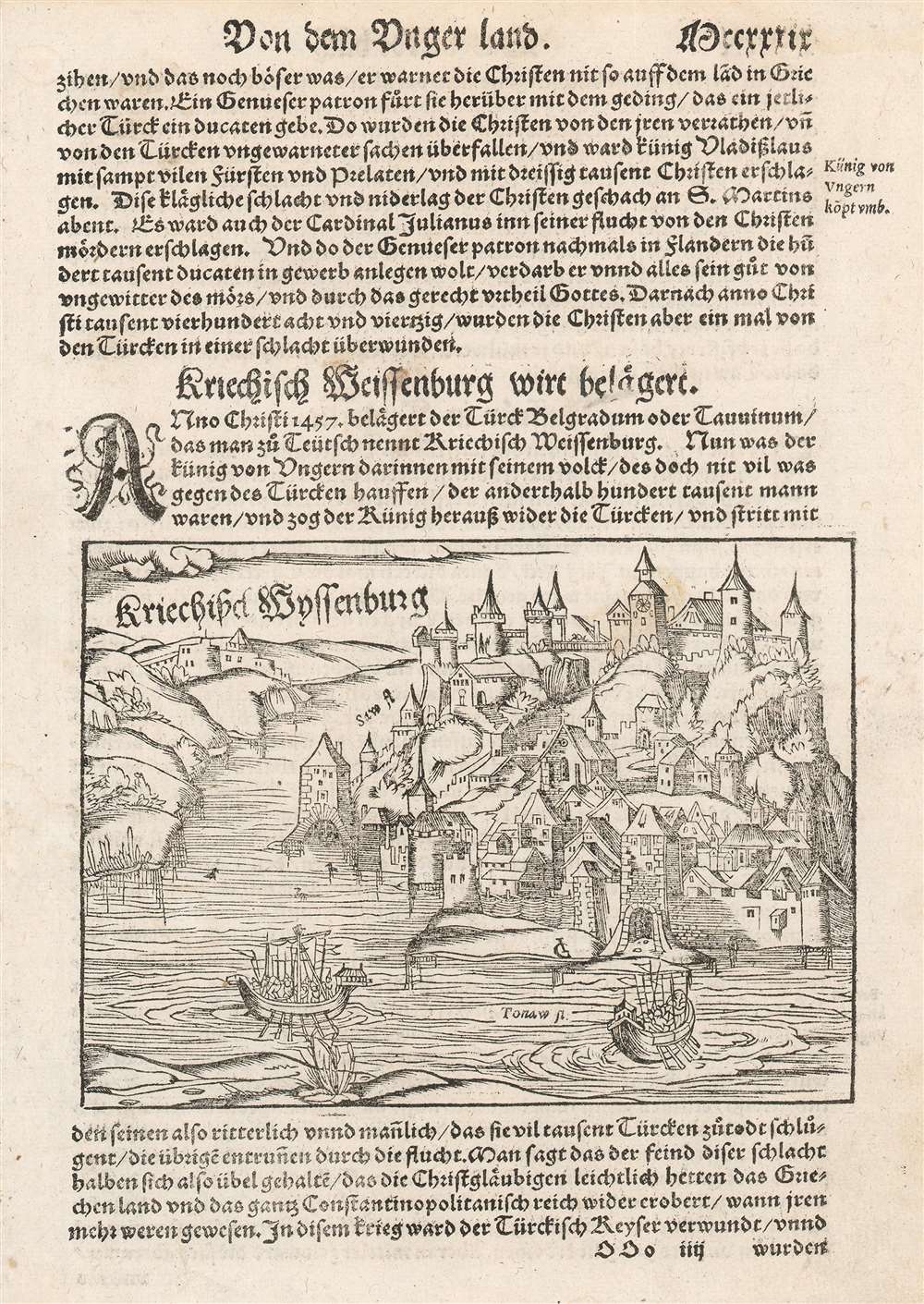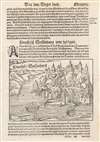
This item below is out of stock, but another example (left) is available. To view the available item, click "Details."
Details
1550 Sebastian Münster View of Belgrade
$300.00
1550 Sebastian Münster View of Belgrade
Belgrade-munster-1550
Title
1550 (undated) 10 x 6.75 in (25.4 x 17.145 cm)
Description
A Closer Look
It depicts the fortified city from across the Danube (here named Tonaw fl). Two boats filled with soldiers appear crossing the river in the foreground. A fortress on the banks of the Sava - an ancillary fortress for Belgrade - is also visible. Münster employs this image as an illustration for the text describing the unsuccessful Turkish siege of Belgrade in 1456, led by Sultan Mehmed II the Conqueror. The irony is that Münster's image is derived from a depiction of an even more recent event, a wood etching by Nuremberg formschneider Wolfgang Resch depicting the 1521 capture of the city by Suleiman the Magnificent. This earlier work, probably executed in 1530, is now unobtainable. When Münster added the view to his Cosmographia, Resch’s etching was the best visual source.German vs. Slavic Toponymy
The name 'Belgrade' does not appear; instead, the scholarly German-Swiss Münster uses the term name Kriechisch (Greichisch) Weißenburg, the common name for Belgrade from the 9th - 16th century. The Slavic name Beligrad appeared as early as the 9th century, but only became broadly accepted in the 17th century.From an Updated Edition
Münster's Cosmographia was first printed in 1544. It was an ambitious attempt at describing, as thoroughly as possible in a single volume, the whole of creation. Plainly, Münster did not consider the work complete with the first edition, and thereafter the work was assiduously expanded. The most dramatically changed edition, printed in 1550, included a great many city views interspersed throughout the work. While most of the woodcut artists, or formschneiders, who produced the images for the book this did not sign their work, many of these city views do include the initials of their creators, and so by the 'CI' cut into the Danube shore we know this to be the work of Iacob Clauser.Publication History and Census
This woodcut was executed by formschneider Iacob Clauser for inclusion in the 1550 edition of Münster's Cosmographia, and remained in every edition to 1628. This example conforms typographically with the 1564 German text edition. The book, in its many editions, is well represented in institutional collections. This image is cataloged separately eight times in OCLC, but once only in this 1564 edition. It appears on the market from time to time.CartographerS
Sebastian Münster (January 20, 1488 - May 26, 1552), was a German cartographer, cosmographer, Hebrew scholar and humanist. He was born at Ingelheim near Mainz, the son of Andreas Munster. He completed his studies at the Eberhard-Karls-Universität Tübingen in 1518, after which he was appointed to the University of Basel in 1527. As Professor of Hebrew, he edited the Hebrew Bible, accompanied by a Latin translation. In 1540 he published a Latin edition of Ptolemy's Geographia, which presented the ancient cartographer's 2nd century geographical data supplemented systematically with maps of the modern world. This was followed by what can be considered his principal work, the Cosmographia. First issued in 1544, this was the earliest German description of the modern world. It would become the go-to book for any literate layperson who wished to know about anywhere that was further than a day's journey from home. In preparation for his work on Cosmographia, Münster reached out to humanists around Europe and especially within the Holy Roman Empire, enlisting colleagues to provide him with up-to-date maps and views of their countries and cities, with the result that the book contains a disproportionate number of maps providing the first modern depictions of the areas they depict. Münster, as a religious man, was not producing a travel guide. Just as his work in ancient languages was intended to provide his students with as direct a connection as possible to scriptural revelation, his object in producing Cosmographia was to provide the reader with a description of all of creation: a further means of gaining revelation. The book, unsurprisingly, proved popular and was reissued in numerous editions and languages including Latin, French, Italian, and Czech. The last German edition was published in 1628, long after Münster's death of the plague in 1552. Cosmographia was one of the most successful and popular books of the 16th century, passing through 24 editions between 1544 and 1628. This success was due in part to its fascinating woodcuts (some by Hans Holbein the Younger, Urs Graf, Hans Rudolph Manuel Deutsch, and David Kandel). Münster's work was highly influential in reviving classical geography in 16th century Europe, and providing the intellectual foundations for the production of later compilations of cartographic work, such as Ortelius' Theatrum Orbis Terrarum Münster's output includes a small format 1536 map of Europe; the 1532 Grynaeus map of the world is also attributed to him. His non-geographical output includes Dictionarium trilingue in Latin, Greek, and Hebrew, and his 1537 Hebrew Gospel of Matthew. Most of Munster's work was published by his stepson, Heinrich Petri (Henricus Petrus), and his son Sebastian Henric Petri. More by this mapmaker...
Heinrich Petri (1508 - 1579) and his son Sebastian Henric Petri (1545 – 1627) were printers based in Basel, Switzerland. Heinrich was the son of the printer Adam Petri and Anna Selber. After Adam died in 1527, Anna married the humanist and geographer Sebastian Münster - one of Adam's collaborators. Sebastian contracted his stepson, Henricus Petri (Petrus), to print editions of his wildly popular Cosmographia. Later Petri, brought his son, Sebastian Henric Petri, into the family business. Their firm was known as the Officina Henricpetrina. In addition to the Cosmographia, they also published a number of other seminal works including the 1566 second edition of Nicolaus Copernicus's De Revolutionibus Orbium Coelestium and Georg Joachim Rheticus's Narratio. Learn More...
Jacob Clauser (1520?-1579?) was a Swiss draftsman, painter and designer for woodcuts. Many of his illustrations appeared in Münster's 'Cosmographia'. Born in Zurich, he was active in the Upper Rhine and Lake Constance region. Learn More...
Wolfgang Resch (fl. 1508-1537) was a German formschneider, printer and publisher active in Nuremberg. Virtually nothing is known of his background. He is known (only) for his 1522 firsthand view of the 1521 Siege of Belgrade, the first printed image of that city. Learn More...
Source
Munster's methodology in Cosmographia is notable in particular for his dedication to providing his readers with direct access to firsthand reports of his subjects wherever possible. Many of the maps were the result of his own surveys; others, the fruit of an indefatigable letter writing campaign to scholars, churchmen and princes throughout Europe, amicably badgering them for maps, views, and detailed descriptions of their lands. For lands further afield than his letters could reach, Munster relied on the best that the authorities of northern European scholarship could offer: he was well familiar with the work of Waldseemuller and other geographers of the early 16th century, and was well connected with the best geographers of his own generation. A disproportionate number of the maps of Cosmographia show contemporary geographical knowledge of the their respective areas for the very first time: The first map to show the continents of the Western Hemisphere; the first map to focus on the continent of Asia; the first modern map to name the Pacific Ocean; the first map to use a key; the first modern map of the British Isles and so on. Even in cases where earlier maps exist, Munster's works very often remain the earliest such acquirable by the collector.




